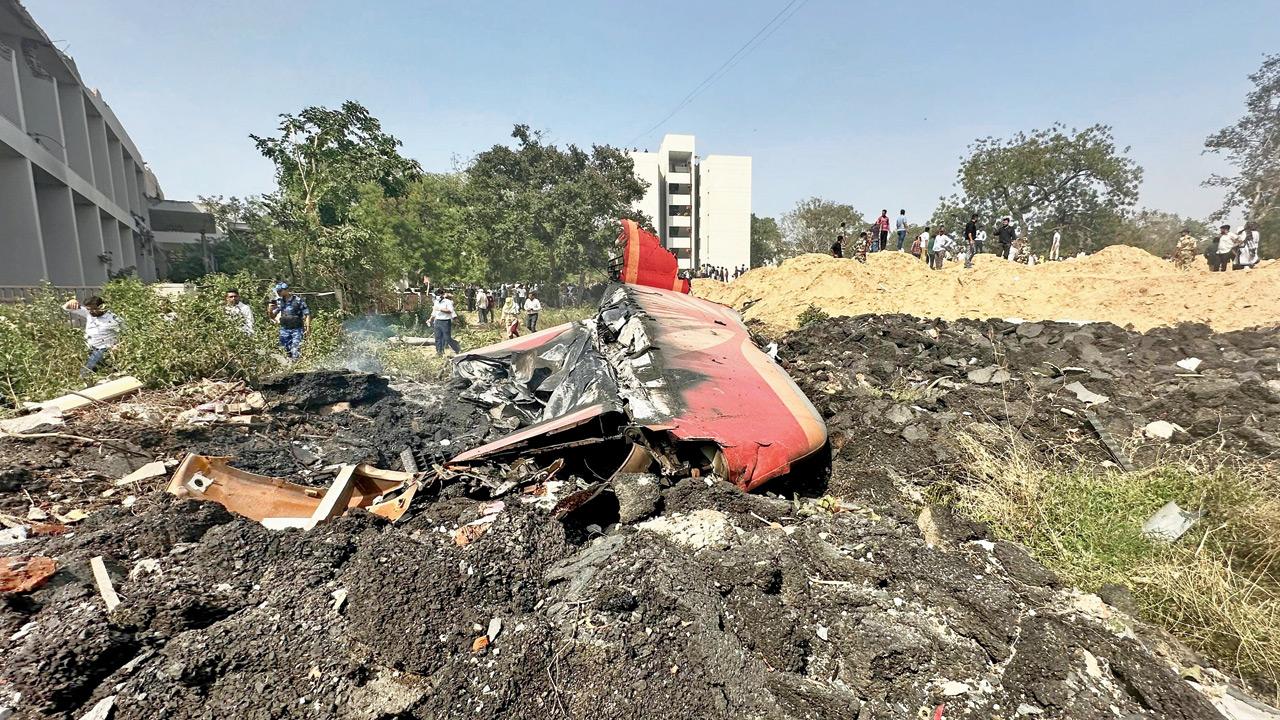The aircraft crashed within minutes of departing from Sardar Vallabhbhai Patel International Airport on Thursday afternoon. Speaking exclusively to mid-day, aviation expert Captain Mohan Ranganathan said the airport is already “notorious for birds”

Debris of Air India Flight AI171 at the crash site on the premises of BJ Medical College in Ahmedabad. Pics/Mayur Bhatt
The fatal crash of a London-bound Air India Boeing 787-8 Dreamliner, operating as Flight AI171 from Ahmedabad to London Gatwick, may have been caused by a bird strike that led to engine failure during the initial climb, according to an aviation expert.
The aircraft crashed within minutes of departing from Sardar Vallabhbhai Patel International Airport on Thursday afternoon. Speaking exclusively to mid-day, aviation expert Captain Mohan Ranganathan said the airport is already “notorious for birds.”
“And to prevent bird strikes, there should be no garbage dumping, no slaughterhouses, etc., within a 13-km radius of a runway. But no municipality or the government enforces this because everything is politically controlled. So, it is most likely that this crash happened due to a bird strike, because Ahmedabad is very notorious for birds,” Ranganathan told mid-day.

Captain Mohan Ranganathan, aviation expert
“The flight was only 400 feet above the ground when it started to descend. So, the chances are high that its engine was struck by birds in the area, causing it to stop functioning. I suspect the bird strike as the sole reason behind this fatal crash that claimed multiple lives,” he said.
“Bird control around airports must be implemented strictly by the concerned authorities,” he added. According to India’s National Aviation Safety Plan 2024–28, effective control of animal/bird activity by the aerodrome operator is limited to 13 km from the Aerodrome Reference Point (ARP).
“Bird ingestion into aircraft engines can cause critical failures, leading to a loss of thrust. Given the low altitude and heavy takeoff weight due to a full fuel load, the flight crew has limited options for recovery. The aircraft can subsequently lose control, resulting in a fatal crash,” Ranganathan said.
To maintain the aircraft’s centre of gravity, fuel is often stored in the wings. Speaking about the aircraft’s capacity, Ranganathan said, “It is an aircraft capable of flying non-stop between India and the USA. This one must have been full of fuel due to diversions caused by disturbances in the Gulf, and with Pakistan’s airspace closed.”
A commercial pilot from Malaysia told mid-day, “Bird strikes on aircraft can range from minor to catastrophic, with the most concerning impact being engine damage, which can lead to power loss or failure. Strikes on other parts of the aircraft, like windshields or control surfaces, can also disrupt flight operations or cause control issues. While most strikes are minor, larger birds or flocks can cause significant damage requiring repairs, delays, or even emergency landings.”
“Bird strike could be one of the suspected causes behind the failure of both engines. Since the pilot declared a mayday call, it indicates an abnormal situation in the cockpit. The pilots likely didn’t have enough time to respond to ATC and were trying to gain altitude,” said the pilot.
“Weight and balance significantly impact takeoff performance and aircraft stability. An aircraft exceeding its maximum takeoff weight requires a longer runway and may have reduced climb rate and angle. Incorrect weight distribution, where the centre of gravity is outside specified limits, can impair controllability and stability, potentially leading to a stall or other control difficulties,” he added.
“The eBird website lists several common birds near Ahmedabad’s Sardar Vallabhbhai Patel International Airport. These include the rock pigeon, Asian koel, little swift, red-wattled lapwing, and black kite. The airport has implemented several bird control measures, including insect control, physical deterrents, and acoustic deterrents,” the pilot told mid-day.
Speaking about aircraft crash survivability, another pilot from the USA said, “The Boeing 787 Dreamliner — a long-range, wide-body passenger jet — comes in various configurations, including the 8, 9, and 10 models. The Air India 787-8 can carry 248 passengers in a two-class seating configuration. The crash survivability rate immediately after takeoff is low because the jet is almost full of fuel for a long-range flight.”
“A heavy aircraft is difficult to handle at low speeds. Although it is highly capable and powerful enough to manage emergencies during takeoff, the large amount of fuel onboard increases the risk of fire, which can be fatal for everyone on board,” he added.
 Subscribe today by clicking the link and stay updated with the latest news!" Click here!
Subscribe today by clicking the link and stay updated with the latest news!" Click here!










